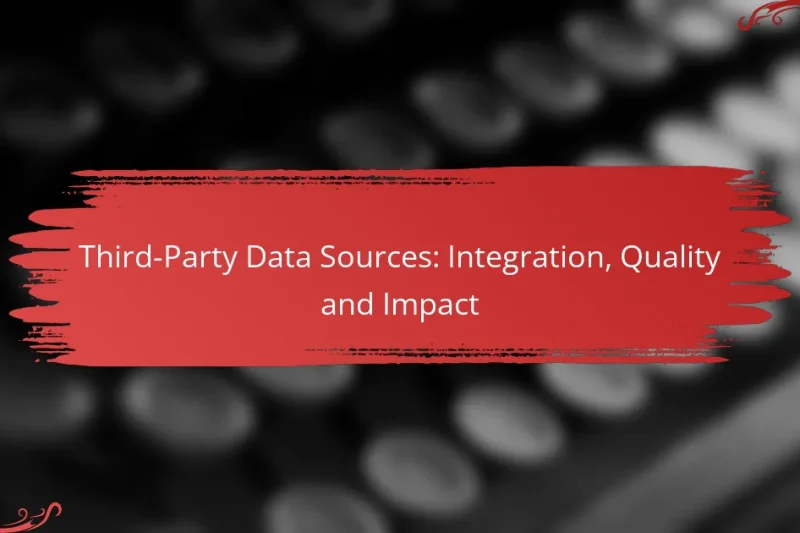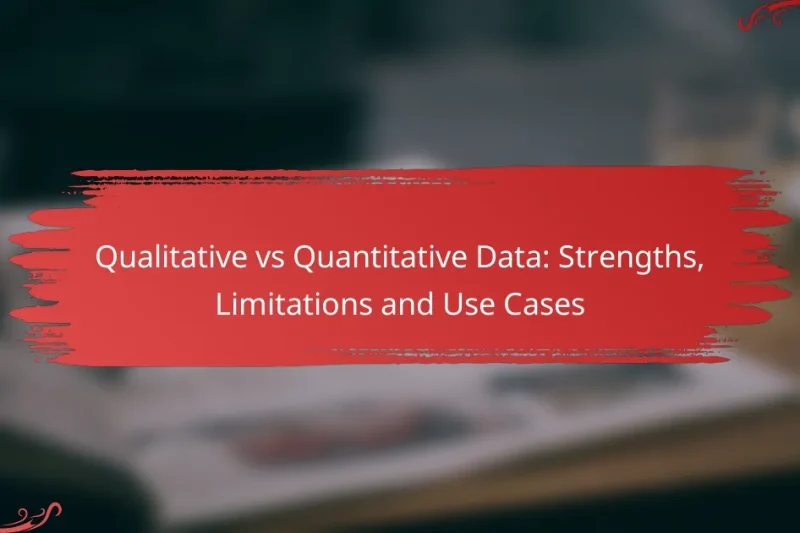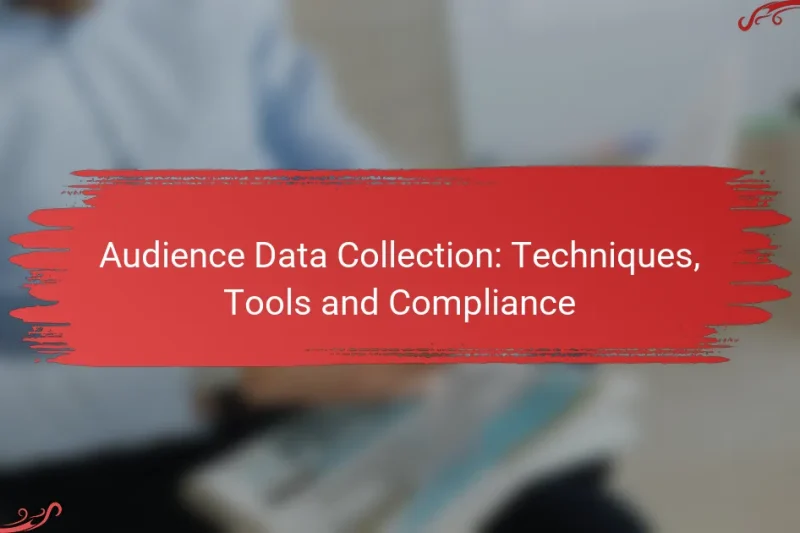Surveys are powerful tools for gathering insights when designed with clear objectives and structured questions. Effective … Surveys: Design, Implementation and AnalysisRead more
Data Collection Techniques
Data collection techniques are vital for businesses seeking to gather accurate and relevant information that drives informed decision-making. From online surveys to in-depth interviews, these methods vary in approach and effectiveness, allowing organizations to tailor their data-gathering strategies to meet specific needs and objectives.
GDPR: Compliance, Impact and Best Practices
The General Data Protection Regulation (GDPR) establishes critical compliance requirements for organizations to safeguard personal data … GDPR: Compliance, Impact and Best PracticesRead more
Third-Party Data Sources: Integration, Quality and Impact
Integrating third-party data sources is crucial for organizations seeking to enhance their data-driven decision-making capabilities. By … Third-Party Data Sources: Integration, Quality and ImpactRead more
Qualitative vs Quantitative Data: Strengths, Limitations and Use Cases
Understanding the differences between qualitative and quantitative data is crucial for effective research and analysis. Qualitative … Qualitative vs Quantitative Data: Strengths, Limitations and Use CasesRead more
Web Scraping Tools: Benefits, Challenges and Applications
Web scraping tools are essential for automating data collection, allowing users to efficiently gather large volumes … Web Scraping Tools: Benefits, Challenges and ApplicationsRead more
Audience Data Collection: Techniques, Tools and Compliance
Audience data collection is essential for understanding user preferences, behaviors, and demographics, employing both qualitative and … Audience Data Collection: Techniques, Tools and ComplianceRead more
Social Media Data: Insights, Trends and Engagement
Social media data plays a crucial role in enhancing user engagement by offering valuable insights into … Social Media Data: Insights, Trends and EngagementRead more
What are effective data collection techniques for businesses?
Effective data collection techniques for businesses include methods that gather accurate and relevant information to inform decision-making. These techniques can vary in approach, cost, and the type of data they yield, making it essential for businesses to choose the right method based on their specific needs.
Surveys and questionnaires
Surveys and questionnaires are popular tools for collecting quantitative and qualitative data from a target audience. They can be distributed online, via email, or in person, and typically include closed-ended questions for easy analysis and open-ended questions for deeper insights.
When designing surveys, keep questions clear and concise to avoid confusion. Aim for a response rate of at least 20-30% to ensure reliability, and consider offering incentives to boost participation.
Interviews and focus groups
Interviews and focus groups provide qualitative insights by facilitating direct interaction with participants. Interviews can be one-on-one or in small groups, allowing for in-depth discussions, while focus groups gather diverse perspectives on a specific topic.
To conduct effective interviews, prepare open-ended questions that encourage detailed responses. For focus groups, limit the number of participants to 6-10 to ensure everyone has a chance to contribute, and create a comfortable environment to foster honest dialogue.
Web scraping
Web scraping involves extracting data from websites to gather information on competitors, market trends, or customer preferences. This technique can be automated using software tools that navigate web pages and collect specified data points.
While web scraping can provide valuable insights, be aware of legal implications and website terms of service. Ensure compliance with regulations such as GDPR when handling personal data, and consider ethical practices to maintain a positive reputation.
Social media monitoring
Social media monitoring tracks online conversations about a brand, product, or industry across various platforms. This technique helps businesses understand public sentiment, identify trends, and engage with customers effectively.
Utilize tools that analyze mentions, hashtags, and engagement metrics to gather actionable insights. Regularly review this data to adapt marketing strategies and improve customer relations based on real-time feedback.
Mobile data collection
Mobile data collection leverages smartphones and tablets to gather information in real-time, often through apps or mobile surveys. This method is particularly useful for field research, allowing businesses to collect data from remote locations efficiently.
Ensure that mobile data collection tools are user-friendly and accessible to participants. Consider offline capabilities for areas with limited internet access, and prioritize data security to protect sensitive information collected through mobile devices.
How can businesses utilize online surveys for data collection?
Businesses can effectively use online surveys to gather valuable data from their customers, employees, or target markets. These surveys provide insights into preferences, behaviors, and satisfaction levels, enabling informed decision-making.
Cost-effective and scalable
Online surveys are a cost-effective method for data collection, often requiring minimal financial investment compared to traditional methods like telephone or face-to-face interviews. Many platforms offer free or low-cost options, making it accessible for businesses of all sizes.
Additionally, online surveys can easily scale to reach thousands or even millions of respondents, allowing businesses to gather a large amount of data quickly. This scalability is particularly beneficial for companies looking to expand their market reach without significantly increasing costs.
Real-time data analysis
One of the key advantages of online surveys is the ability to analyze data in real-time. Many survey tools provide instant reporting features, enabling businesses to view responses as they come in. This immediacy allows for quick adjustments to strategies based on emerging trends or feedback.
For example, if a survey reveals a sudden drop in customer satisfaction, a business can promptly investigate the issue and implement changes. This agile approach can significantly enhance customer relations and retention.
Targeted audience reach
Online surveys allow businesses to target specific demographics or customer segments, ensuring that the data collected is relevant and actionable. By using criteria such as age, location, or purchasing behavior, companies can tailor their surveys to gather insights from the most pertinent audiences.
For instance, a company launching a new product can survey existing customers who fit the target profile, leading to more focused feedback that directly informs product development and marketing strategies. This targeted approach maximizes the value of the data collected.
What are the benefits of using interviews for data collection?
Interviews provide valuable benefits for data collection, including the ability to gather rich, qualitative information directly from participants. This method fosters a deeper understanding of respondents’ thoughts, feelings, and motivations, making it ideal for exploratory research.
In-depth insights
Interviews allow researchers to delve into complex topics, uncovering nuances that surveys might miss. By engaging in conversation, interviewers can probe deeper into responses, leading to a more comprehensive understanding of the subject matter. For instance, a researcher might explore a participant’s experiences with a product, revealing specific pain points that could inform future improvements.
Personalized engagement
Conducting interviews enables a tailored approach to data collection, where the interviewer can adapt questions based on the participant’s responses. This personalized engagement helps build rapport, encouraging participants to share more openly. For example, a skilled interviewer might shift the focus of the discussion based on a participant’s emotional reactions, leading to richer data.
Flexible questioning
Interviews offer the flexibility to modify questions on the fly, allowing for a dynamic conversation that can explore unexpected topics. This adaptability is particularly useful when new themes emerge during the discussion. Researchers should prepare a set of core questions but remain open to following interesting tangents that may arise, as these can lead to valuable insights.
What criteria should businesses consider when choosing data collection methods?
Businesses should evaluate several key criteria when selecting data collection methods, including target audience characteristics, data accuracy and reliability, and budget constraints. These factors help ensure that the chosen methods align with business goals and yield useful insights.
Target audience characteristics
Understanding the target audience is crucial for effective data collection. Consider demographics such as age, location, and preferences, as these factors influence how and where to collect data. For example, younger audiences may respond better to online surveys, while older demographics might prefer phone interviews.
Additionally, assess the audience’s familiarity with technology. If the target group is less tech-savvy, simpler methods like paper surveys or face-to-face interviews may be more effective. Tailoring the approach to the audience increases engagement and response rates.
Data accuracy and reliability
Data accuracy and reliability are essential for making informed decisions. Choose methods that minimize bias and errors, such as randomized sampling or validated survey instruments. For instance, online surveys can provide quick feedback but may suffer from self-selection bias.
Implementing pilot tests can help identify potential issues with data collection methods before full deployment. Regularly reviewing and validating data sources also ensures that the information gathered remains trustworthy and relevant.
Budget constraints
Budget constraints significantly impact the choice of data collection methods. Businesses should assess the costs associated with various techniques, including personnel, technology, and materials. For example, online surveys are often more cost-effective than in-person interviews, especially for larger audiences.
Consider the trade-offs between cost and quality. While cheaper methods may save money upfront, they might compromise data quality. Establishing a clear budget and prioritizing essential data needs can help in selecting the most effective and affordable options.
How does web scraping enhance data collection?
Web scraping significantly enhances data collection by automating the process of gathering information from websites. This technique allows businesses and researchers to efficiently collect large volumes of data, which can be analyzed for insights and trends.
Automated data extraction
Automated data extraction refers to the use of software tools to retrieve information from web pages without manual intervention. These tools can navigate websites, extract relevant data, and store it in structured formats like CSV or databases, making it easier to analyze.
Key considerations for automated data extraction include selecting the right tools, understanding the website’s structure, and ensuring compliance with legal regulations such as the GDPR in Europe. Popular tools for this purpose include Scrapy, Beautiful Soup, and Octoparse.
When implementing automated data extraction, it’s crucial to avoid overloading the target website’s server. Set reasonable scraping intervals and respect the site’s robots.txt file to ensure ethical practices. Additionally, consider the potential need for data cleaning and validation after extraction to ensure accuracy and relevance.






